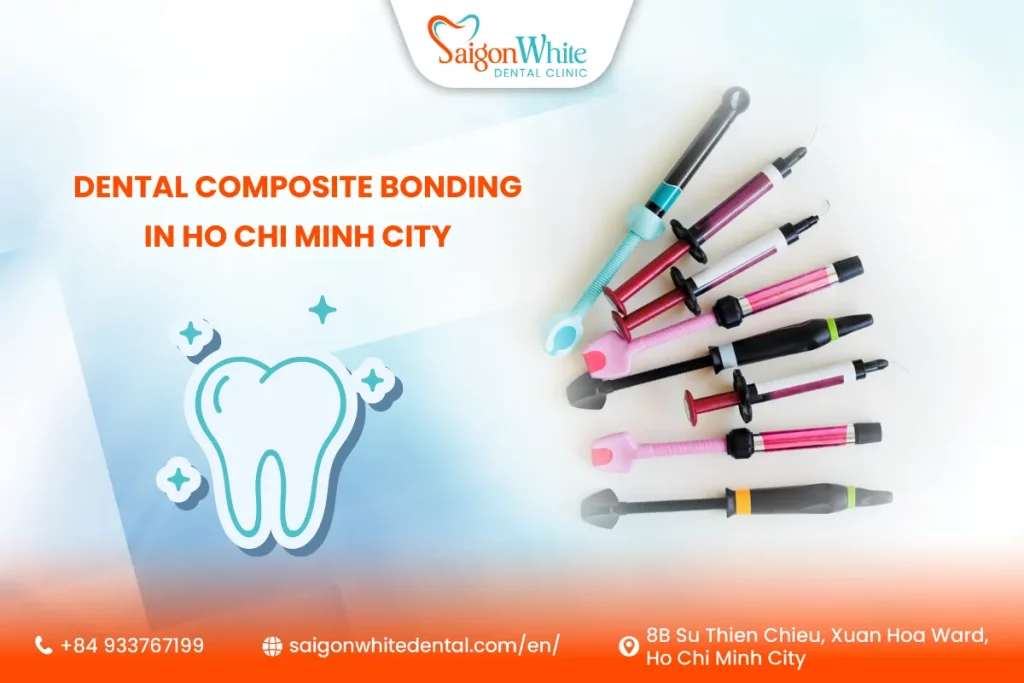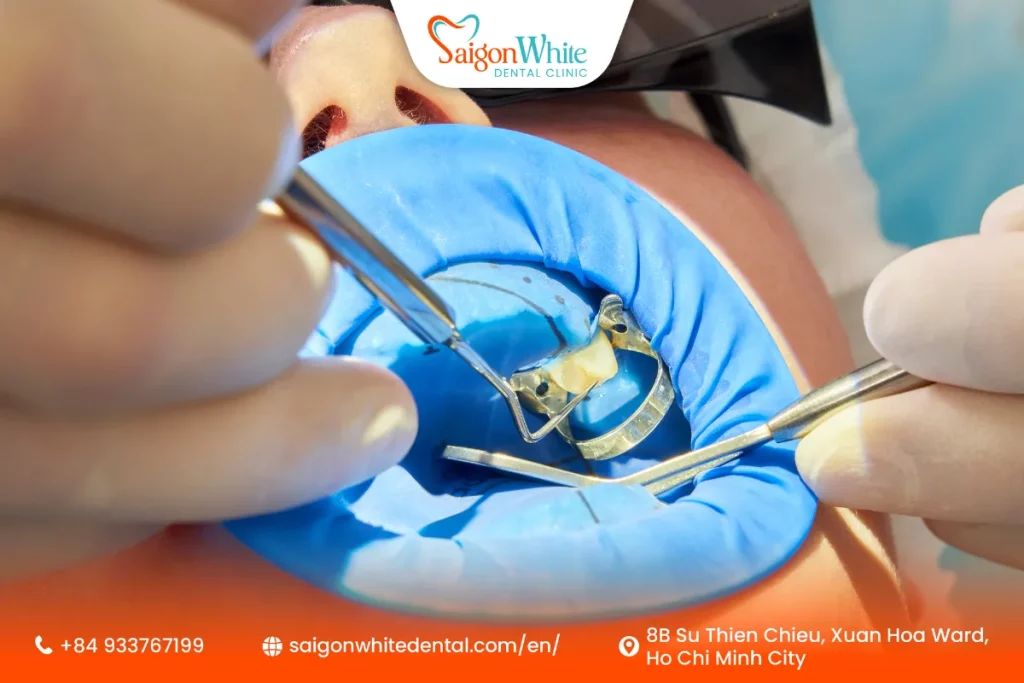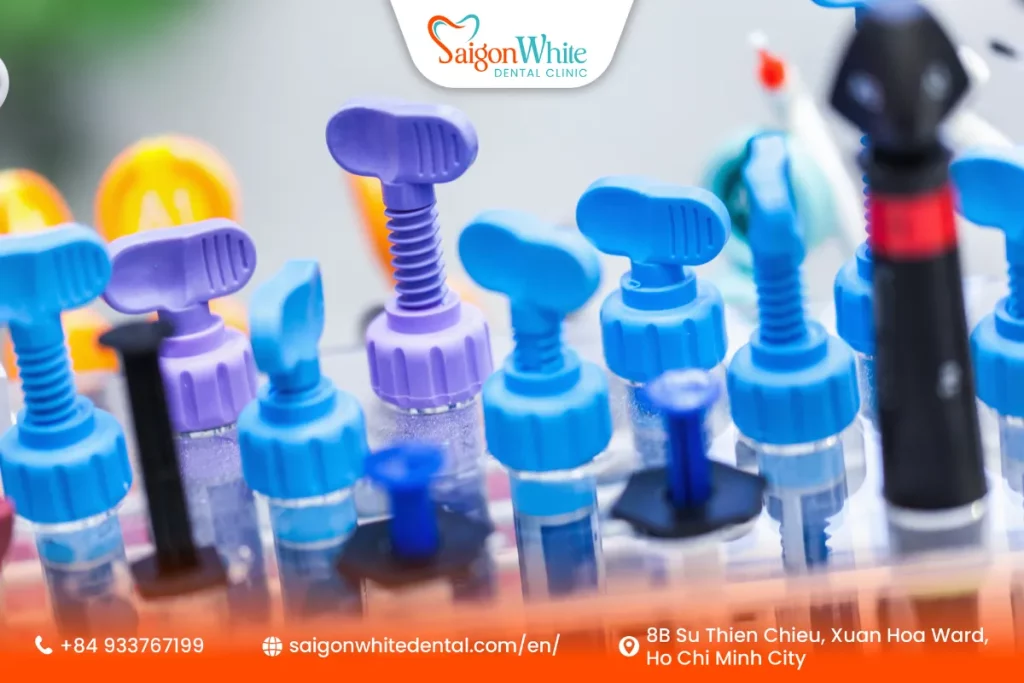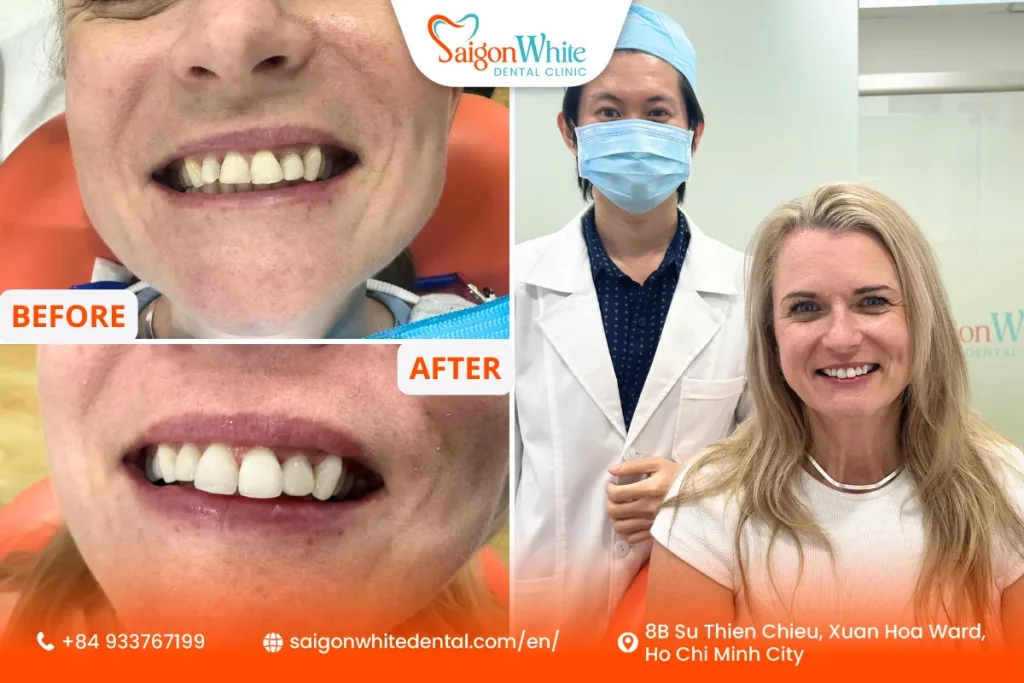Composite bonding in Vietnam has quickly become one of the most sought-after cosmetic dental treatments for those looking to enhance their smiles naturally and affordably. With its blend of artistry and advanced dental technology, Vietnam — particularly Ho Chi Minh City — is emerging as a top destination for smile makeovers.
Whether you’re a local resident, an expat living in Vietnam, or a traveler exploring the country, you’ll find that dental clinics here offer international-standard composite bonding services at a fraction of the cost compared to Western countries.
In this guide, we’ll take you through everything you need to know about composite bonding in Vietnam — from the procedure and benefits to cost, aftercare, and where to find the most reputable clinics.

What Is Dental Composite Bonding?
Composite bonding is a cosmetic dental technique that involves applying a tooth-colored resin material to the teeth to improve their appearance. The resin is molded and polished to match surrounding teeth, providing a natural look and feel.
What Issues Can Composite Bonding Fix?
- Chipped or cracked teeth
- Gaps between teeth
- Discolored or stained teeth
- Misshapen or short teeth
- Minor misalignments
Unlike veneers or crowns, composite bonding is a minimally invasive solution that doesn’t require removing much tooth enamel.
Benefits of Dental Composite Bonding in Vietnam

Dental composite bonding has become one of the most popular cosmetic treatments worldwide because it offers a wide range of advantages for patients who want to enhance their smile without undergoing complex or invasive procedures.
Unlike veneers or crowns, which often require significant reshaping of the tooth, composite bonding is a conservative, quick, and versatile solution. Some of the most important benefits include:
1. Aesthetic Improvement
Composite bonding can dramatically improve the appearance of teeth by covering imperfections such as chips, cracks, gaps, discoloration, or irregular shapes.
The composite resin is carefully color-matched to the natural tooth shade, ensuring a seamless and natural look. This makes it an excellent choice for patients seeking a brighter, more even smile.
2. Minimally Invasive Procedure
One of the main advantages of composite bonding is that it preserves the natural tooth structure. In most cases, there is little to no need for drilling or removal of enamel, unlike veneers or crowns. This makes bonding a safe and conservative option, ideal for patients who want to protect their natural teeth while still achieving cosmetic improvement.
3. Quick and Convenient
Composite bonding can usually be completed in just one dental visit, depending on the number of teeth being treated. This makes it perfect for patients who want instant results without multiple appointments. The procedure itself is relatively short and requires minimal preparation.
4. Cost-Effective Solution
Compared to porcelain veneers or dental crowns, composite bonding is significantly more affordable while still delivering noticeable results. This makes it accessible to a wider range of patients who want to enhance their smile without investing in more expensive treatments.
5. Versatility in Treatment
Composite resin is a highly adaptable material, allowing dentists to fix multiple issues at once. Whether it’s closing small gaps, reshaping uneven teeth, lengthening short teeth, or repairing minor fractures, composite bonding provides a flexible solution tailored to each patient’s needs.
6. Reversible and Repairable
Unlike permanent procedures that require irreversible tooth reduction, composite bonding can be adjusted, repaired, or replaced with ease. If the material chips, discolors, or wears down over time, the dentist can simply add or reshape the composite without affecting the natural tooth underneath.
Why Choose Composite Bonding at Saigon White Dental?

Expert Cosmetic Dentists
Our cosmetic team is trained in minimally invasive aesthetic dentistry, ensuring every bonded tooth looks natural and blends seamlessly with your smile.
Premium Composite Materials
We use high-quality resin composites imported from Japan, Germany, and the U.S. for excellent durability, stain resistance, and lifelike color.
International-Standard Care
From sterilization to equipment, Saigon White Dental follows protocols similar to Western clinics. You can expect clear communication, transparency, and professionalism.
English-Speaking Team
All consultations and procedures are handled in fluent English, ensuring peace of mind for expats and dental tourists.
Fast and Comfortable
Most composite bonding cases are completed in 30–90 minutes, with no anesthesia or downtime. Perfect for short-term visitors and busy professionals.
Dental Tourism-Friendly
- Fast scheduling for travelers
- Flexible appointments and same-day treatments
- English-speaking staff and online consultation options
Perfect for Expats
- No language barrier
- Consistent follow-up and documentation
- A professional environment that feels like home
Save Money Without Sacrificing Quality
- Up to 70% cheaper than U.S., Australian, or European clinics
- No compromise on materials, sterilization, or technique
The Composite Bonding Process in Vietnam (Step-by-Step)
Smile Consultation
Every bonding treatment starts with a personalized consultation:
- Discuss your aesthetic goals
- Examine your teeth, alignment, and bite
- Assess the color, size, and shape of current teeth
- Take photos for planning and shade matching
You’ll receive recommendations tailored to your facial structure, smile line, and desired outcome.
Shade Matching
Using a dental shade guide and natural lighting, we match the composite resin to your existing teeth to ensure a seamless, lifelike result.
Tooth Preparation
- The tooth surface is gently roughened
- A bonding liquid is applied to create a strong bond
- No drilling or anesthesia required in most cases
Application & Shaping
The dentist applies soft composite resin in layers, sculpting it carefully to the desired shape and contour using artistic precision.
Hardening
A blue curing light is used to harden the composite instantly.
Final Shaping & Polishing
Once the material is set, the dentist fine-tunes the shape and polishes the bonded tooth to a natural-looking shine.
Bite Check
Your bite is checked to ensure comfort and function. Minor adjustments are made if necessary.
Who Is a Good Candidate for Composite Bonding?

Composite bonding is suitable for many patients, especially those with mild to moderate cosmetic concerns. Below are the most common candidate profiles:
People With Chipped or Cracked Teeth
If you have small chips or surface cracks (not involving deep structural damage), bonding can restore the tooth’s shape and protect it from further wear.
Those With Small Gaps Between Teeth (Diastema)
Composite bonding can close minor gaps between front teeth, offering a more uniform smile without the need for orthodontic treatment.
Individuals With Discolored Teeth
For teeth that are stained or discolored and don’t respond well to whitening treatments, bonding can cover the stains and create a brighter appearance.
Patients With Short or Worn-Down Teeth
Bonding can build up worn or naturally small teeth to improve proportion and alignment, particularly in smile design cases.
People With Misshapen Teeth
If you have uneven, pointed, or irregularly shaped teeth, bonding can enhance symmetry and aesthetics without surgery or braces.
Patients Seeking a Budget-Friendly Smile Makeover
Compared to porcelain veneers or crowns, bonding is a cost-effective way to enhance multiple teeth at once, ideal for those on a tighter budget.
Patients Looking for a Reversible or Trial Solution
Since bonding is reversible (unlike veneers), it’s perfect for patients who want to try out a cosmetic change before committing to a more permanent solution.
Who May Not Be an Ideal Candidate for Composite Bonding?
While composite bonding is versatile, it’s not the right solution for everyone. You may not be an ideal candidate if:
- You have significant tooth decay or gum disease. These must be treated first
- You bite your nails, grind your teeth (bruxism), or chew ice. These habits can damage the bonding material
- Your teeth are severely misaligned or overcrowded – Orthodontic treatment may be more appropriate
- You need a long-lasting solution in high-stress areas. Crowns or veneers may be better for molars or back teeth
- You want long-term whitening. Bonding material can stain over time and doesn’t respond to whitening agents.
How to Know If You’re a Good Candidate?
The best way to determine if composite bonding is right for you is to book a dental consultation. During this visit, your dentist will:
- Assess your oral health (gum and tooth condition)
- Discuss your aesthetic goals
- Evaluate your bite and tooth alignment
- Take photos or impressions for treatment planning
Can Composite Bonding Be Combined with Other Treatments?
Yes — in modern cosmetic dentistry, composite bonding is often combined with other dental treatments to achieve more comprehensive and natural-looking results. In fact, one of the main strengths of composite bonding lies in its versatility and ability to complement a wide range of procedures.
Today, patients rarely rely on a single treatment alone; instead, dentists create customized smile makeover plans that may integrate bonding with whitening, orthodontics, veneers, or even implants.
1. Composite Bonding and Teeth Whitening
Many patients choose to undergo professional teeth whitening before composite bonding. This ensures that the natural teeth are brightened first, and then the composite resin is color-matched to the new shade. If bonding is done before whitening, the resin will not lighten, leading to mismatched tones.
Therefore, whitening followed by bonding has become a common practice for patients who want an overall brighter, more uniform smile.
2. Composite Bonding and Orthodontics
For patients who have completed orthodontic treatment with braces or clear aligners, composite bonding can be the final touch to perfect their smile.
Bonding is often used to reshape uneven teeth, repair worn edges, or close small gaps that remain even after alignment. This combination is particularly popular among adults who want both straightness and aesthetic refinement.
3. Composite Bonding with Veneers or Crowns
In some cases, dentists may combine bonding with porcelain veneers or crowns. For example, a patient might choose veneers for the most visible front teeth but use bonding on adjacent teeth to maintain uniformity while reducing overall cost. Similarly, bonding can be used to make small adjustments around crowns without needing full replacements.
4. Composite Bonding and Dental Implants
While bonding cannot replace missing teeth the way implants do, it can enhance the overall smile alongside implants. For example, after an implant crown is placed, composite bonding may be applied to neighboring natural teeth to improve their shape or color, ensuring that the entire smile looks balanced.
5. Current Trends in Dentistry
In recent years, there has been a rise in “smile makeover” packages, which integrate composite bonding with multiple treatments in a single plan. Clinics often advertise combined solutions such as “whitening + bonding” or “orthodontics + bonding” as a cost-effective way to achieve a complete transformation. This trend reflects a growing demand for minimally invasive yet comprehensive aesthetic solutions.
How Much Does Composite Bonding Cost at Saigon White Dental?
We offer transparent, affordable pricing:
| Dental Service | Price (USD) |
| Composite Bonding (per tooth) | $40 – $80 |
| Full Smile Design (6–8 teeth) | $250 – $500 |
| Consultation & Scan | Often Free |
Note: Prices vary depending on tooth location, condition, and number of teeth treated.
Compared to veneers (often $250–$500/tooth), bonding is a budget-friendly solution for achieving noticeable improvements.
Composite Bonding vs. Veneers vs. Crowns
| Feature | Bonding | Veneers | Crowns |
| Invasiveness | Minimal | Moderate (some enamel removal) | High (extensive tooth prep) |
| Reversibility | Yes | No | No |
| Cost per Tooth | Low ($40–$80) | Medium ($250–$400) | High ($300–$800) |
| Time Required | 30–60 mins | 1–2 visits | 2–3 visits |
| Durability | 3–7 years | 10–15 years | 10–20 years |
Bonding is a perfect entry-level cosmetic solution for those not ready to commit to more permanent or costly procedures.
Aftercare Tips for Bonded Teeth
To maintain your results for years:
- Brush twice a day with a soft toothbrush
- Floss daily to prevent staining at the gum line
- Avoid excessive coffee, tea, red wine, or smoking
- Don’t bite on ice, fingernails, or hard candy
- If you grind your teeth, use a night guard
- Visit Saigon White Dental every 6 months for a check-up and polish
Composite bonding is not as stain-resistant as veneers, but with good habits, it can last 3 to 7 years or longer.

 Telegram
Telegram